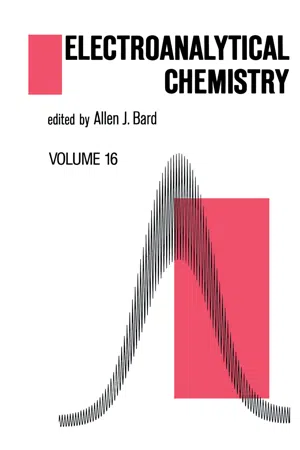
- 360 pages
- English
- ePUB (mobile friendly)
- Available on iOS & Android
eBook - ePub
About this book
This volume provides authoritative reviews in the field of modern electroanalytical chemistry defined in its broadest sense. It is valuable to practicing analytical chemists interested in learning about and applying electroanalytical techniques.
Frequently asked questions
Yes, you can cancel anytime from the Subscription tab in your account settings on the Perlego website. Your subscription will stay active until the end of your current billing period. Learn how to cancel your subscription.
No, books cannot be downloaded as external files, such as PDFs, for use outside of Perlego. However, you can download books within the Perlego app for offline reading on mobile or tablet. Learn more here.
Perlego offers two plans: Essential and Complete
- Essential is ideal for learners and professionals who enjoy exploring a wide range of subjects. Access the Essential Library with 800,000+ trusted titles and best-sellers across business, personal growth, and the humanities. Includes unlimited reading time and Standard Read Aloud voice.
- Complete: Perfect for advanced learners and researchers needing full, unrestricted access. Unlock 1.4M+ books across hundreds of subjects, including academic and specialized titles. The Complete Plan also includes advanced features like Premium Read Aloud and Research Assistant.
We are an online textbook subscription service, where you can get access to an entire online library for less than the price of a single book per month. With over 1 million books across 1000+ topics, we’ve got you covered! Learn more here.
Look out for the read-aloud symbol on your next book to see if you can listen to it. The read-aloud tool reads text aloud for you, highlighting the text as it is being read. You can pause it, speed it up and slow it down. Learn more here.
Yes! You can use the Perlego app on both iOS or Android devices to read anytime, anywhere — even offline. Perfect for commutes or when you’re on the go.
Please note we cannot support devices running on iOS 13 and Android 7 or earlier. Learn more about using the app.
Please note we cannot support devices running on iOS 13 and Android 7 or earlier. Learn more about using the app.
Yes, you can access Electroanalytical Chemistry by Allen J. Bard in PDF and/or ePUB format, as well as other popular books in Physical Sciences & Analytic Chemistry. We have over one million books available in our catalogue for you to explore.
Information
Electrochemical Aspects of Low-Dimensional Molecular Solids
Central Research and Development DepartmentE. I. du Pont de Nemours & Company, Inc. Experimental Station 328, Wilmington, Delaware
I. Introduction
II. Description of Low-Dimensional Solids
III. Redox Properties of Molecular Solids
A. Electrochemical Properties of Molecular Solid Components
B. Role of Redox Behavior in Solid-State Properties
IV. Electrochemical Preparation of Low-Dimensional Solids
A. Basic Principles
B. Examples
C. Mechanistic Aspects
D. Role of Electrochemical Parameters in Crystallization
E. Electrochemical Doping of Low-Dimensional Phthalocyanines
V. Low-Dimensional Solids as Electrode Materials
A. Characteristics of Solid Electrodes
B. Potential Applications of “Synthetic Metal” Electrodes
C. Other Electrode Materials
VI. Summary
Appendix: Definitions of Acronyms
References
I. INTRODUCTION
The trend toward electronic devices with very small dimensions and desirable electronic characteristics has led to extensive investigations of molecular materials, that is, those materials designed on the basis of molecular principles. The intense interest in these materials has been aroused mainly by the promise of facile modification of their physical and electronic properties through rational approaches, which would facilitate investigation of structure-function relationships and possibly the design of molecular-scale electronic devices [1,2]. Interest in molecular materials was heightened with the discovery of the organic conductor TTF-TCNQ (TTF = tetrathiafulvalene, TCNQ = tetracyanoquinodimethane) [3,4], followed by the discovery of superconductivity in (TMTSF)2X (TMTSF = tetramethyltetraselenafulvalene; X = PF6-, CIO4-, AsF6-, ReO4-) [5]. Since that time, the area has grown substantially, including the discovery of numerous organic conductors and superconductors [6 8], electrically conductive organometallic solids [9], and a vast number of conducting polymers [10]. Electronic conductivities at room temperature ranging from semiconducting and insulating values (ca 10-9 −10-1 Ω-1 cm-1) to actual metallic conductivity (ca 1–105 Ω-1 cm-1) have been observed, in addition to the superconducting materials that exhibit zero resistivity at very low temperatures. Optoelectronic properties, such as nonlinear optical phenomena arising from unique lattice structures and intermolecular interactions in these materials [11,12], and cooperative magnetic behavior [13 15], such as ferromagnetism [16], have recently expanded the scope of possibilities for molecular materials.
This review will concern the class of molecular materials designated as molecular solids, which are defined as containing discrete molecular components that have been condensed into an organized framework, generally as a result of intermolecular interactions, crystal forces, or Van der Waals forces. As a corollary, molecular solids can generally be redissolved to their molecular components. They are therefore distinguished from other molecularly designed systems that possess extended covalent networks, such as conducting [10] or redox polymers [17] (e.g., polypyrrole, poly acetylene, or polyvinylferrocene), inorganic chain compounds [e.g., Zintl ions (18)], or two-dimensional layered materials (e.g., metal chalcogenides and molybdates).
Because molecular solids are composed of discrete molecular components, the ability to manipulate and understand the properties of the isolated constituents on the molecular level allows rational modification of the properties of the condensed solid. The properties of the individual molecules play an important role in the unique intermolecular interactions in the crystalline solid state, which ultimately result in the cooperative electronic behavior commonly observed in these materials. To the extent that the electrochemical properties are generally indicative of the electr...
Table of contents
- Cover
- Half Title
- Title Page
- Copyright Page
- Introduction to the Series
- Contributors to Volume 16
- Contents of Volume 16
- Contents of Other Volumes
- Voltammetry Following Nonelectrolytic Preconcentration
- Hydrodynamic Voltammetry in Continuous-Flow Analysis
- Electrochemical Aspects of Low-Dimensional Molecular Solids
- Author Index
- Subject Index